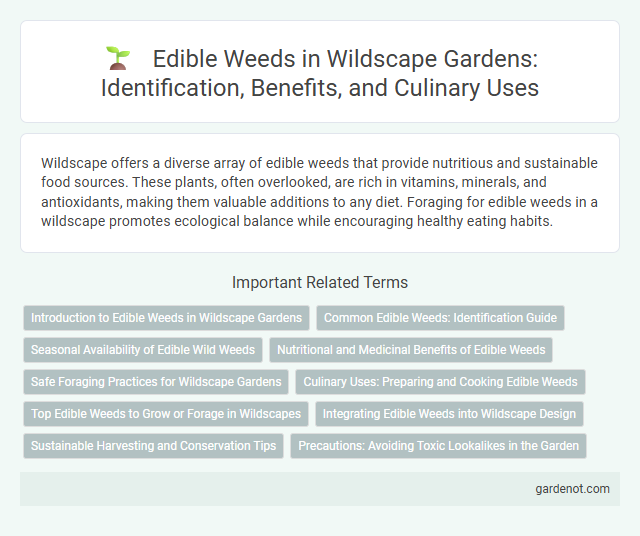Wildscape offers a diverse array of edible weeds that provide nutritious and sustainable food sources. These plants, often overlooked, are rich in vitamins, minerals, and antioxidants, making them valuable additions to any diet. Foraging for edible weeds in a wildscape promotes ecological balance while encouraging healthy eating habits.
Introduction to Edible Weeds in Wildscape Gardens
Edible weeds in Wildscape Gardens offer a valuable source of nutrition and biodiversity, featuring plants such as dandelion, purslane, and lamb's quarters rich in vitamins and minerals. These hardy species thrive naturally in the garden ecosystem, requiring minimal cultivation while enhancing soil health and supporting pollinators. Incorporating edible weeds into Wildscape Gardens promotes sustainable foraging practices and reconnects visitors with traditional, nutrient-dense food sources.
Common Edible Weeds: Identification Guide
Common edible weeds such as dandelion, chickweed, and purslane offer abundant nutritional benefits and can be identified by key features: dandelion has bright yellow flowers with deeply toothed leaves, chickweed displays small white star-shaped flowers and succulent stems, while purslane boasts fleshy, smooth leaves and reddish stems. These resilient plants thrive in various environments, making them accessible for foraging in wildscapes. Recognizing these weeds can enhance outdoor culinary experiences and promote sustainable food sourcing.
Seasonal Availability of Edible Wild Weeds
Edible wild weeds such as dandelion, chickweed, and purslane exhibit distinct seasonal availability, with dandelion flourishing in early spring through late summer, chickweed thriving in cool, moist conditions predominantly in spring and fall, while purslane peaks during the warm summer months. Foragers benefit from understanding these patterns to harvest nutrient-rich greens at optimal times, ensuring maximum flavor and potency. Seasonal shifts influence the growth cycles of these weeds, directly impacting the foraging windows throughout the year in diverse habitats.
Nutritional and Medicinal Benefits of Edible Weeds
Edible weeds such as dandelion, chickweed, and nettle offer rich sources of vitamins A, C, and K, minerals like iron and calcium, and antioxidants that support overall health. These plants possess anti-inflammatory, diuretic, and immune-boosting properties, making them valuable for natural medicine and dietary supplements. Incorporating edible weeds into Wildscape environments enhances biodiversity while providing accessible, nutrient-dense food options with proven medicinal benefits.
Safe Foraging Practices for Wildscape Gardens
Foraging edible weeds in Wildscape gardens requires thorough identification to ensure plant safety and avoid toxic species. Using gloves and clean tools minimizes contamination risks, while harvesting from areas free of pesticides or pollution safeguards health. Proper washing and preparing of weeds further guarantee safe consumption for gardeners and wildlife alike.
Culinary Uses: Preparing and Cooking Edible Weeds
Edible weeds like dandelion, chickweed, and purslane are versatile ingredients in Wildscape culinary creations, offering unique flavors and nutritional benefits. Preparing these weeds involves thorough washing to remove soil and bitterness, followed by methods such as sauteing, steaming, or incorporating them raw into salads and pesto. Cooking techniques that preserve their delicate texture and vibrant taste enhance dishes while promoting sustainable foraging practices.
Top Edible Weeds to Grow or Forage in Wildscapes
Top edible weeds to grow or forage in wildscapes include purslane, dandelion, and lamb's quarters, all rich in vitamins and antioxidants. Purslane offers omega-3 fatty acids and thrives in diverse soil conditions, while dandelion provides detoxifying properties and can be used in salads or teas. Lamb's quarters, often compared to spinach, is packed with minerals like calcium and iron, making these weeds valuable, nutrient-dense additions to any wildscape for sustainable, foraged nutrition.
Integrating Edible Weeds into Wildscape Design
Integrating edible weeds such as dandelion, purslane, and chickweed into wildscape design enhances biodiversity while providing foraging opportunities and natural pest control. These hardy plants thrive in diverse conditions, requiring minimal maintenance and contributing to soil health through deep root systems. Incorporating edible weeds supports sustainable landscapes by fostering ecosystem balance and offering a nutritious, accessible food source.
Sustainable Harvesting and Conservation Tips
Sustainable harvesting of edible weeds in Wildscape involves selective picking to ensure plant populations remain robust and ecosystems balanced. Avoid uprooting entire plants and harvest only mature leaves or stems to promote regrowth and habitat stability. Conservation efforts emphasize awareness of local species, respecting protected areas, and encouraging community-driven stewardship to maintain biodiversity.
Precautions: Avoiding Toxic Lookalikes in the Garden
When foraging for edible weeds in a wildscape garden, accurately identifying each plant is crucial to avoid toxic lookalikes that can cause severe health issues. Implementing clear labeling and using reliable field guides significantly reduce the risk of mistaking harmful species for edible ones. Regularly educating oneself about plant characteristics and consulting experts ensures safe and sustainable foraging practices within the wildscape environment.
Edible weed Infographic

 gardenot.com
gardenot.com